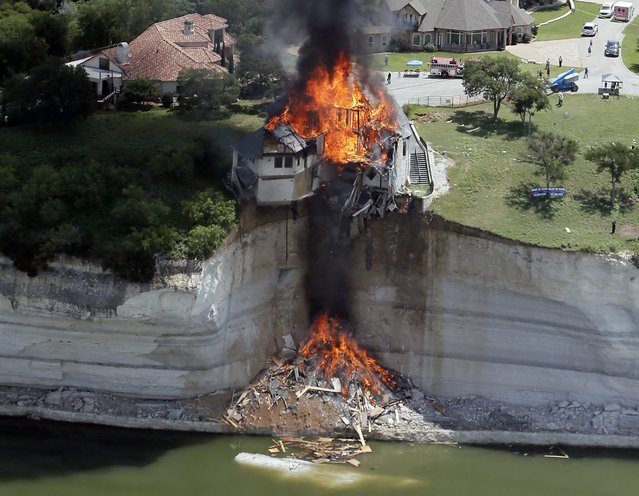
Smoke rises from a house days after part of the ground it was resting on collapsed into Lake Whitney, Texas in this June 13, 2014 file photo. I was covering the controlled burn of a house slowly falling into Lake Whitney due to the decaying cliff underneath. Asked to take photos from an aerial perspective, an instructor and I took off from Grand Prairie Municipal Airport around 9am. The burn, scheduled to start an hour later, was delayed. I love flying, but patience proved challenging as circling for nearly three hours gets boring fast. Once the fire started we only had 15 minutes to take photos because the plane was booked at 1pm. The owners invested their retirement savings in the house and were even advised by geologists that the ground was stable. To watch your investment literally go up in flames must take its toll emotionally. The owners said they don't expect their insurance to cover the loss. (Photo and caption by Brandon Wade/Reuters)
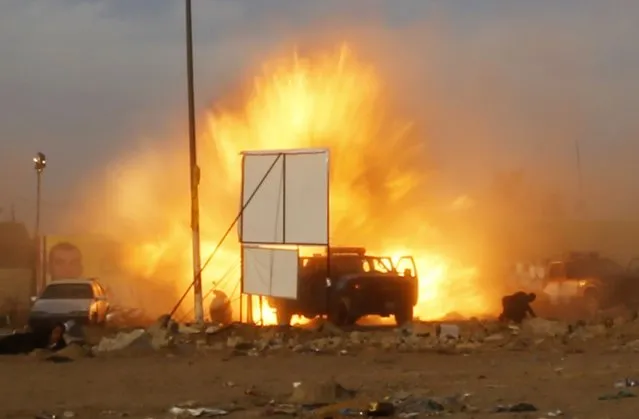
An explosion is seen during a car bomb attack at a rally by militant group, Asaib Ahl Haq (League of the Righteous), to introduce its candidates for elections at a soccer stadium in Baghdad, in this April 25, 2014 file photo. After I was done taking pictures and trying to reach our driver's vehicle to return to the office a powerful blast hit an exit gate. We tried to find a place to hide because we were expecting a secondary explosion and at the same time we were keen to keep ocumenting the incident. Screams of the wounded, black smoke and bodies surrounded us, while security forces and militia members were shooting in the air to disperse the crowd. I tried to take cover behind anything close by. Along with Reuters cameraman Mahdi Talaat we could only hit the ground and film the event that was taking place in front of us. Then a minibus that was advancing towards the site caught our attention. The car was only a few meters away from our position and heading towards a gate when it blew up. The blazing fire, smoke and the blast's shockwave along with shrapnel raining down on us and the wailing of the wounded made us believe that we were witnessing judgment day. This incident has had a great impact on myself and resulted in raising my awareness and developing a great internal fear of street gatherings, protests and celebrations. Images of the incident are still fresh in my mind and they keep replaying in my head every time I see a large gathering of people and it even haunts me in my sleep at times. (Photo and caption by Thaier al-Sudani/Reuters)
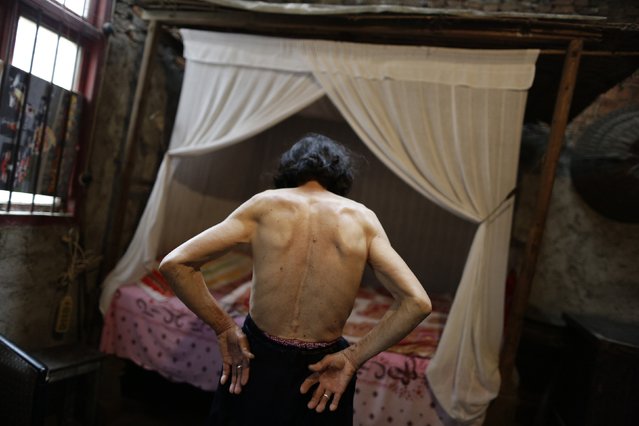
Qin Zhengyu, 78, shows moles and tumours on her back in her home at Heshan village, in Shimen county, central China's Hunan Province, in this June 4, 2014 file photo. Heshan is in an area rich in realgar, or arsenic disulphide, and is sometimes given the grim label “cancer village”. Factories and mines sprang up to process this precious resource but they were shut down in 2011 because of the pollution they caused. Heshan residents said that many had died from cancer caused by arsenic poisoning. I am no stranger to death and during my coverage of the 2008 Sichuan earthquake, I was witness to huge-scale tragedy. But this was the first time I saw people who lived as though they had a sword hanging over their heads all the time. The desperation and hopelessness were unimaginable. (Photo and caption by Jason Lee/Reuters)
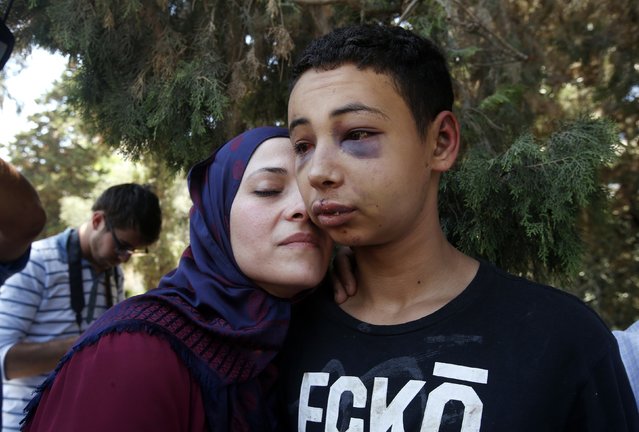
Tariq Khdeir is greeted by his mother after being released from jail in Jerusalem July 6, 2014. The picture was taken outside the courthouse following the release of Khdeir, a 15-year-old American of Palestinian descent, whose beating by Israeli police during a violent protest in East Jerusalem drew U.S. concern. Tariq Khdeir from Tampa, Florida, is a cousin of 16-year-old Palestinian Mohammed Abu Khudair, who was abducted and killed in July 2014 in a suspected revenge attack for the killing of three Israeli youths by Palestinian militants in the occupied West Bank. Three Israelis have been arrested and charged on suspicion of killing Abu Khudair. The abduction and killing of three Israeli youths by Palestinian militants in June 2014 caused alarm throughout Israel and set off a cycle of violence, including the killing of Mohammed Abu Khudair in a suspected revenge attack. Khudair's killing – three Israelis have been charged with his murder – led to clashes between Palestinian youths and Israeli police in East Jerusalem. (Photo and caption by Ronen Zvulun/Reuters)
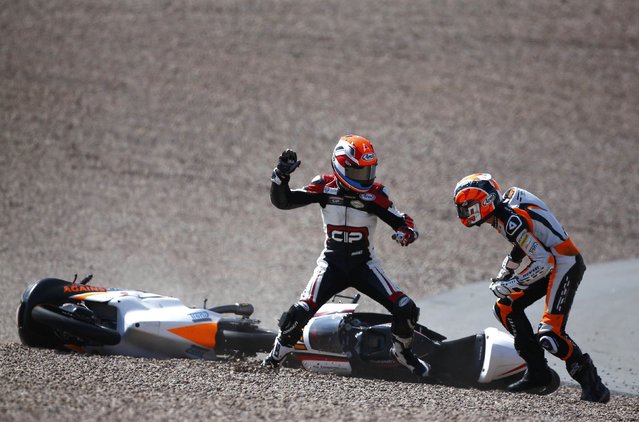
Mahindra Moto3 rider Bryan Schouten of the Netherlands fights with compatriot Kalex KTM Moto3 rider Scott Deroue (R) after they crashed during the German Grand Prix at the Sachsenring circuit in Hohenstein-Ernstthal in this July 13, 2014 file photo. During lap 26, towards the end of the race, I was standing behind the tire barrier in the first bend waiting for the pack of riders. I decided to make this lap the last one before changing position to shoot the winner crossing the finishing line further up the track. When the pack approached, two riders came skidding out of the pack, losing contact with their bikes and coming to a halt in the gravel traps a mere two metres away from each other. It was impossible to make what had actually happened as the incident that led to the crash was obscured by the other riders. But Schouten seemed to be sure who was to blame. He jumped to his feet and started to lay into his compatriot, Scott Deroue, kicking and punching his helmet. After initially blocking the attack somewhat coyly, Deroue became equally furious and responded in kind. The two had to be separated by several medics and race attendants who struggled to bring the brawl to an end. (Photo and caption by Thomas Peter/Reuters)
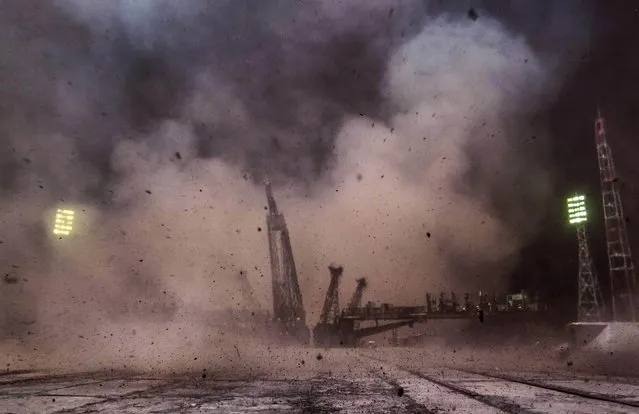
Debris flies after the Soyuz TMA-14M spacecraft blasted off from the launch pad at the Baikonur Cosmodrome in this September 26, 2014 file photo. How on earth could I take a close-up shot of a Soyuz rocket as it blasted off amid orange flames? Especially when to comply with safety requirements, I was in a photography position over a kilometre away from the rocket. The answer was to leave a remote camera at the launch pad. This led to the second question, due to technical issues photographers can't control the remote cameras they leave at the launch pad. So how would I trigger my camera? The launch of a Soyuz into orbit is meticulously calculated to the last second. This precision provided the answer to my dilemma – a simple photo-timer the size of a mobile phone. What remained to be done was as simple as ABC – to calculate the hours, minutes and seconds before the takeoff and set the timer on countdown. I prepared the rest of my kit; as well as my camera, this included a bag for gravel to keep the tripod steady, sandwich wrapping, and scotch tape. I had a soft, sealed ball perched on a tripod – with a lens curiously sticking out. As Soyuz lifted off in clouds of dust, the wind changed a blast of eastern wind curled and the sand lifted by the roaring Soyuz blew back to the launch pad, straight towards our remote cameras. Only my sandwich' ball was still standing firmly upright. A bullet-like hole proudly gaping in the filter, and the plastic wrapping melted on top. I was thinking with horror about my broken lens, because my next assignment was just a day away. Luckily, sandwiches appear to be well protected these days! A broken filter was my only loss, and I had my shot. (Photo and caption by Shamil Zhumatov/Reuters)
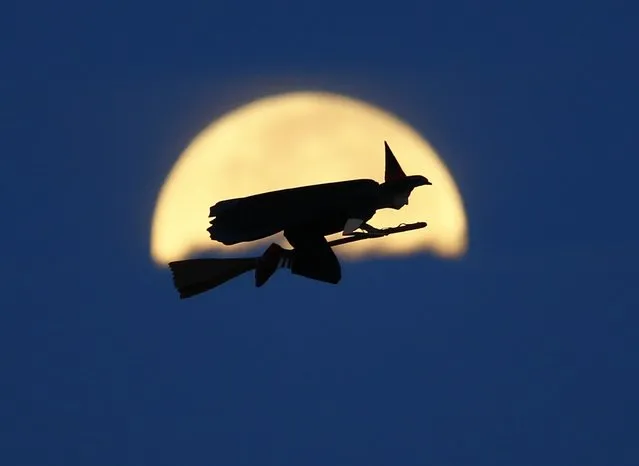
A radio-controlled flying witch makes a test flight past a moon setting into clouds along the pacific ocean in Carlsbad, California in this October 8, 2014 file photo. The witch is actually a radio controlled airplane powered by an electric motor. The inventor Otto Dieffenbach III invited me to shoot a test flight as he was keen to fly his invention through a full moon. I have no idea how he makes it fly but it's amazing just to watch, freaky actually. Shooting was a bit of a challenge, as the moon was setting into the ocean fog and there needed to be a slight bit of dawn light for some separation in order to focus on the witch and not the moon. It was only near the end of the 15 minute battery powered flight that it all came together with the flight path, light, focus and timing. (Photo and caption by Mike Blake/Reuters)
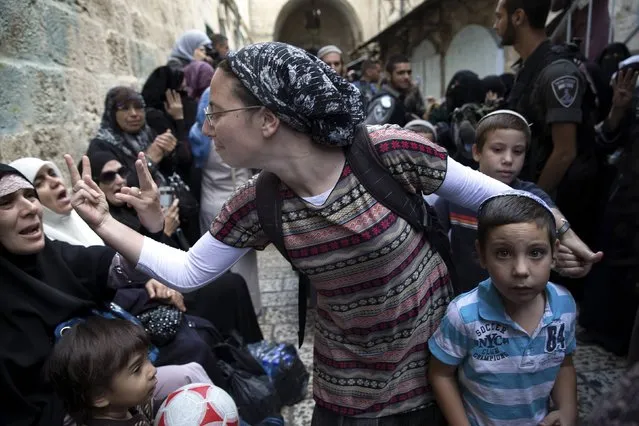
An Israeli woman (C) and a Palestinian woman gesture at one another during a protest by Palestinian women against Jewish visitors to the compound known to Muslims as Noble Sanctuary and to Jews as Temple Mount in Jerusalem's Old City in this October 14, 2014 file photo. The Palestinian women were singing and chanting in Arabic while heavily armed Israeli border police looked on and occasionally pushed them back to make way for Jewish worshipers going to the Western Wall. The Palestinian women shouted and harassed Jewish passersby while Orthodox Jews living in apartments above the street threw bottles and water down at the Palestinian women. About half a dozen Orthodox Jewish worshipers wanted to pass along the narrow street toward the Western Wall and the Israeli border police created a passageway through the crowd of Palestinian women. As the Israelis walked between the shouting protesters I focused on the woman in the center of the scene. When she was right in front of me, she turned and gestured to the Palestinian woman. It wasn't something done for the camera – I don't think she even realized I was there. It was only when I looked at the picture afterward that I realized that the Palestinian woman had returned the gesture, which in this part of the world is the equivalent to giving someone the middle finger. (Photo and caption by Finbarr O'Reilly/Reuters)
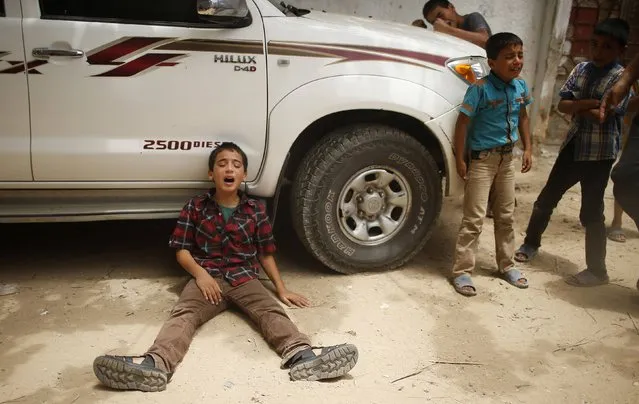
The son (L) of one of the members of Tayseer Al-Batsh's family, who hospital officials said were killed in an Israeli air strike, mourns during their funeral in Gaza City in this July 13, 2014 file photo. The strike on the family home of Al-Batsh, Gaza's police chief, killed 18 people. While I was shooting this picture loud explosions from air strikes could be heard and battles from the ground offensive were ongoing. Moments before taking this pix, mourners brought out the bodies of the family members and their relatives started to cry and shout. Suddenly, this boy fell on the ground and burst into tears shouting: “My dad, my dad”. The situation was risky and I had to take the pictures quickly and leave the area as fast as possible. This picture has affected me the most from the war. As a father, I was totally shocked and sad to hear this boy crying out for his dead father. (Photo and caption by Mohammed Salem/Reuters)
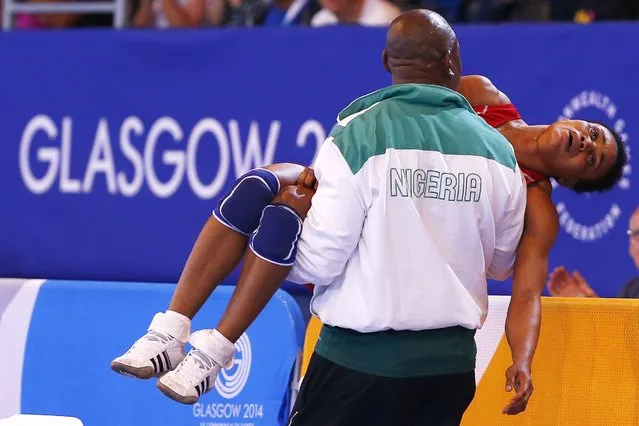
Ifeoma Nwoye of Nigeria is carried away by her coach after she lost her women's freestyle 55kg wrestling semi-final at the 2014 Commonwealth Games in Glasgow, Scotland, in this July 31, 2014 file picture. The picture was shot during the Commonwealth Games in Glasgow. In the image, the wrestler's coach is carrying her away after she lost her bout. It was not immediately clear to me whether she had been injured in the contest or whether she was simply upset at having lost. The Nigerian woman lost and was knocked out of the competition by the eventual gold medallist who easily overpowered her. There was a moment of serendipity as I followed the coach and wrestler out as the games logo formed a halo around her head which helps the viewer focus on the expression on her face. The whole moment was over in a second, and the tournament carried on. If anything I suppose the picture shows that sometimes in sport a moment of crushing disappointment can be just as engaging as a moment of victory. (Photo and caption by Andrew Winning/Reuters)
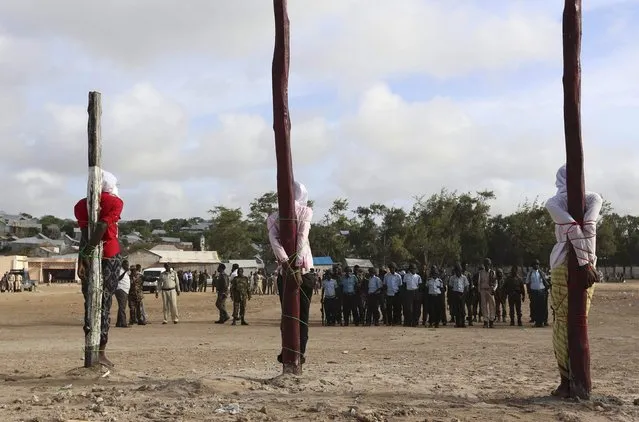
Three men found guilty by a Somali military court of killing civilians and masterminding a recent attack on the Presidential Palace stand tied to poles shortly before they were executed by a firing squad in capital Mogadishu in this August 3, 2014 file photo. I was covering the execution of three Somali men who were accused of being members of Islamist militant group al Shabaab. I took the photo while the men were still alive and tied to poles. Once they were shot, I could see blood gushing from their head, chest and stomach. They died within seconds, but we were not allowed to take pictures of their dead bodies. It was shocking to see men just waiting to be killed and unable to escape because they were tied tight to strong poles. The story really affected me and I panicked because I was watching human beings being executed. It was terrible to see their blood as they writhed, and to hear them scream. (Photo and caption by Feisal Omar/Reuters)
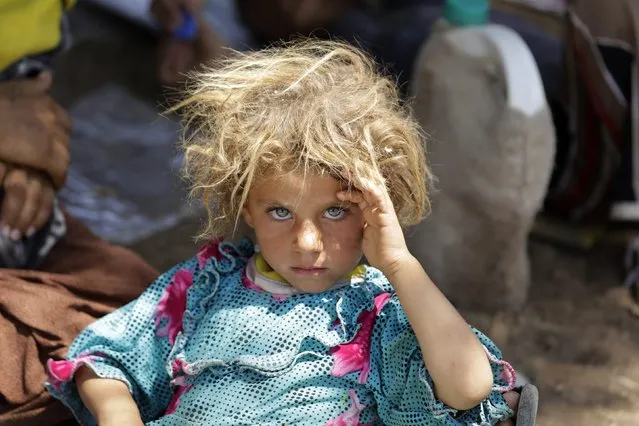
A girl from the minority Yazidi sect rests after fleeing violence in Sinjar, in this August 13, 2014 file photo. I remember the scene well. It was the day that I arrived at the Iraqi-Syrian border crossing of Fishkhabour. With shocked, sunburnt faces, men, women and children in dirt-caked clothes were struggling in temperatures of over 45 degrees Celsius (113 Fahrenheit). At first, I focused my camera on a group of women sitting on the ground, but when I turned away I saw this little girl. I took one shot of her there and as she saw me, she gave me a smile. I captured another frame of her with her mother. I was drawn to her wild beauty in this terrible situation. There is a kind of intensity, distress and sadness in her eyes. It was really sad not only to see this girl, but also to see the hundred others who were dirty, exhausted, and sitting amongst garbage in the heat. I would be very curious to see the blonde girl who I photographed again. I wonder what will become of her. I wonder what will become of all the others. (Photo and caption by Youssef Boudlal/Reuters)
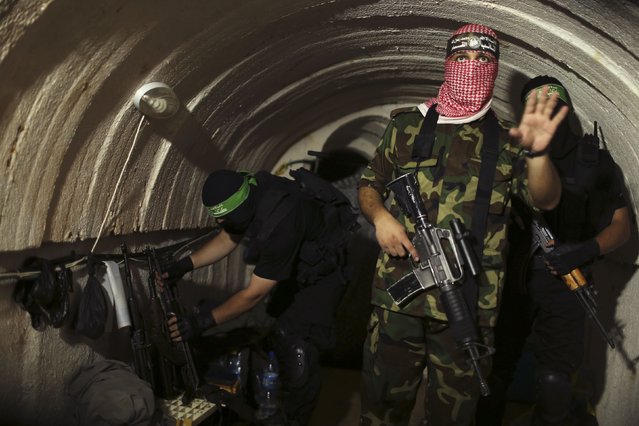
A Palestinian fighter from the Izz el-Deen al-Qassam Brigades, the armed wing of the Hamas movement, gestures inside an underground tunnel in Gaza in this August 18, 2014 file photo. A rare tour that Hamas granted to a Reuters reporter, photographer and cameraman appeared to be an attempt to dispute Israel's claim that it had demolished all of the Islamist group's border infiltration tunnels in the Gaza war. I was part of a Reuters team who were given exclusive access to take pictures of the tunnels used by Hamas' armed wing to fight against Israel. We were blindfolded by Hamas militants and guided to an undisclosed location. Suddenly I found myself inside a dark and scary tunnel. I could barely breathe inside the place it was so deep and cold. The dim light and narrowness of the tunnel made it very difficult to take pictures. It was a very special story as the Reuters team were the first people to be allowed into the tunnels. The pictures were published in many papers and magazines around the world. (Photo and caption by Mohammed Salem/Reuters)
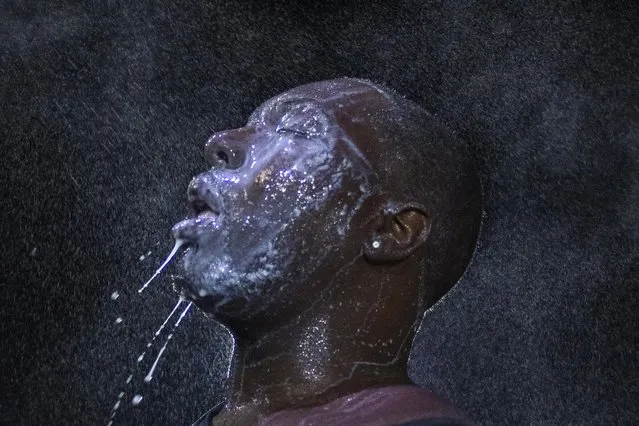
A man is doused with milk and sprayed with mist after being hit by an eye irritant from security forces in Ferguson, Missouri in this August 20, 2014 file photo. As the evening rolled past midnight, I saw one man among the crowd who looked particularly agitated. He seemed to be a local resident, very upset with the police, and people were holding him back as he yelled towards the officers. As he kept shouting, the police targeted him with some kind of eye irritant it looked like pepper spray. He wasn't very close, but they got him right in the eye and his friends immediately pulled him to a parking lot nearby, where they poured milk on his face to flush away the effects of the spray. As they started to pour the milk, I began photographing and noticed a bright spotlight in the background. I believe it was from the police. At that point the people taking care of the man started spraying mist or water to further clear his eyes and I positioned my camera and used the light source to create a rim light around his head and bring attention to the droplets. (Photo and caption by Adrees Latif/Reuters)
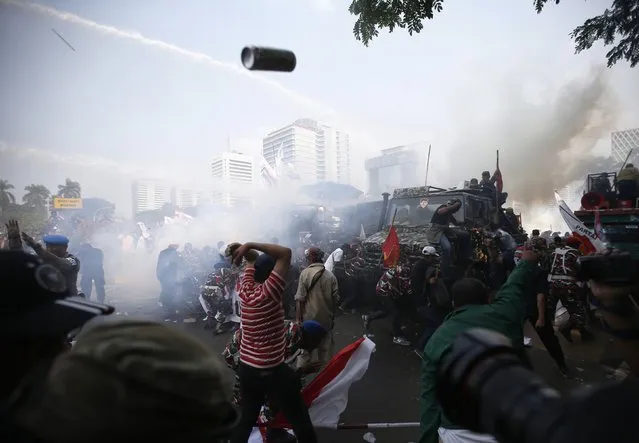
Indonesian police use tear gas and water cannon to disperse supporters of presidential candidate Prabowo Subianto in Jakarta in this August 21, 2014 file photo. After Prabowo supporters had been taunting the police who were holding the barricade, the police launched a very quick and violent strike to disperse them. I had a helmet on so I was able to stand my ground for a few seconds while sticks, rocks and teargas flew through the air – added to that I had attack dogs right behind me. The clash was fast and decisive. The supporters were not expecting such a violent reaction and dispersed. It was all over in a few minutes. (Photo and caption by Darren Whiteside/Reuters)
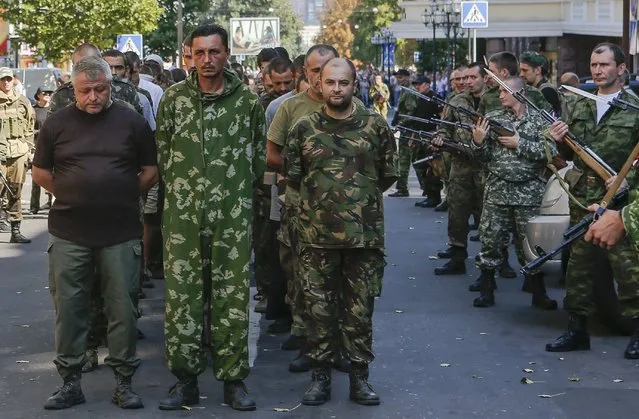
Armed pro-Russian separatists (R) escort a column of Ukrainian prisoners of war as they walk across central Donetsk in this August 24, 2014 file photo. It was an awful sight: A column of jaded and haphazardly dressed people walking along the street surrounded by armed rebels. Citizens were shouting curses and throwing eggs at them. The column was followed by street sweepers washing the road after the prisoners. The scene looked like a farce or copy of the parade of German prisoners in World War Two in Moscow in 1945. I think this image perfectly shows the negative emotions of conflict: weakness, devastation, shame, fear on one side and spite, aggression, rage and desire for revenge on the other. It reminded of a quote “History repeats itself, first as a tragedy, second as a farce”. (Photo and caption by Maxim Shemetov/Reuters)
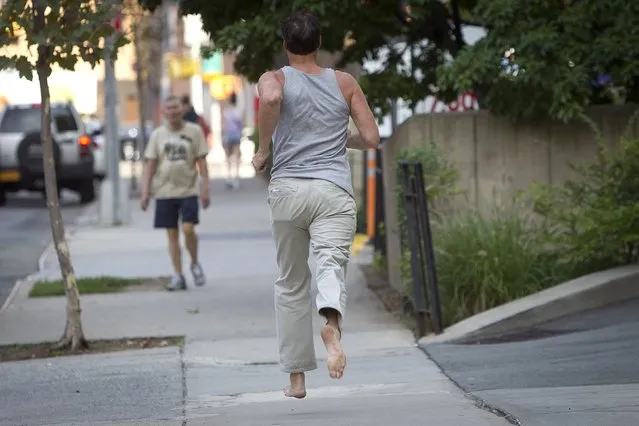
Michael Lucarelli runs from the media as he leaves the federal court building after posting bail in the Manhattan borough of New York in this August 26, 2014 file picture. Outside the courthouse I was waiting for Lucarelli when a photographer friend from a local paper stopped by to chat and ask me what was going on, I told him it was a minor fraud case that we were covering. His paper wasn't interested in the case at all. A network TV crew was there covering another story. Lucarelli looked out the door and saw the two photographers and a TV crew and thought they were all for him. He ducked back inside for a moment, then came back through the revolving door and took off at a full sprint. He ran away so fast that his sandals flew off his feet, which is what made the photo and caused the other media to run to the story. If he had just walked out, TV and the other photographer would have never sent their images. (Photo and caption by Carlo Allegri/Reuters)
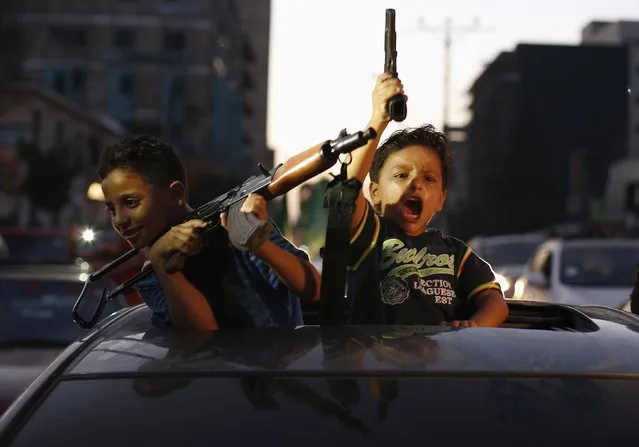
Palestinian children hold guns as they celebrate with others what they said was a victory over Israel, following a ceasefire in Gaza City in this August 26, 2014 file photo. I was covering the celebrations by Palestinians moments after the declaration of a ceasefire that ended a 51-day fighting between Israel and Hamas. Throwing sweets and chanting slogans, people took to the streets, riding vehicles and motorcycles, to celebrate what they said was victory over Israel. Moments before taking this picture, the battles between Israel and Gaza's militants were taking place and explosions could be heard till the truce was announced. The scene was special as children were smiling, holding a pistol and weapon, and showing no sign of fear. It was quite difficult to take the picture since there was not enough light, and the car was driving quickly. My movement was also restricted due to the traffic jams and flows of people in the streets. (Photo and caption by Suhaib Salem/Reuters)
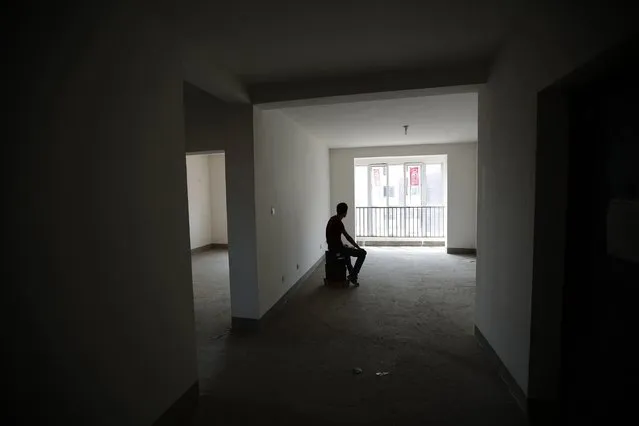
Zhiliang, whose fiancee was onboard Malaysia Airlines Flight MH370 which disappeared on March 8, 2014, is silhouetted at an empty house which he had planned to decorate with her for their marriage, in Tianjin, in this August 26, 2014 file photo. Almost six months had passed since the Malaysian Airlines MH370 disappeared. Although authorities concluded that the plane crashed in the remote Indian Ocean and lost all the passengers, many family members refuse to accept that conclusion. They hope that they are still alive. However, public interest towards this incident faded, so I decided to record what these family members are still going through and shed light on this mysterious incident once again. I thought that portrait-style pictures showing family members together with the missing passengers' mementos would tell a story. I was very careful not to hurt their feelings or invade their privacy when taking these pictures. My first priority was showing my respect for the family members, so before photographing them, I would wait to ask their permission to take pictures until I felt that they were ready and would always spend some time listening to them talk. Sometimes this brought tears to my eyes. (Photo and caption by Kim Kyung Hoon/Reuters)
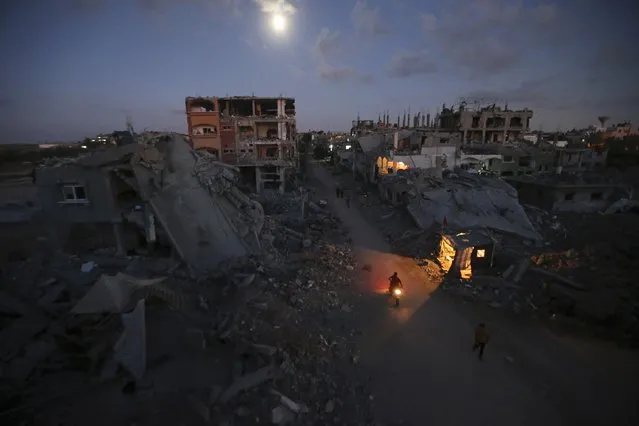
Palestinian pedestrians and a motorcyclist commute along a road between ruins of houses, which witnesses said were damaged or destroyed during the Israeli offensive, in Beit Hanoun town in the northern Gaza Strip in this September 7, 2014 file photo. I was shooting pictures of houses that were destroyed during the 51-day war in Gaza to cover the life of displaced people after the offensive. I was moving from the ruins of one house to another adjacent house where people were staying in makeshift shelters in their devastated neighbourhood. The man riding a motorcycle past destroyed houses captured my attention. It was not easy to get the picture as the light was very dim and I was very lucky that a light from a car illuminated the motorcycle. (Photo and caption by Mohammed Salem/Reuters)
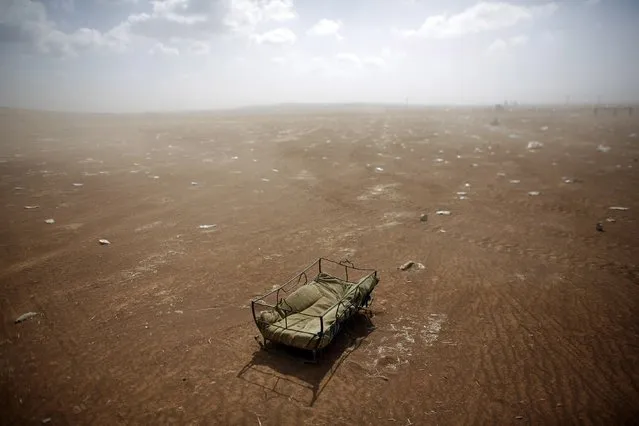
A cradle left behind by Syrian Kurdish refugees lies at the Turkish-Syrian border near Suruc, in this September 27, 2014 file photo. A crossing point along the Turkish-Syrian border frontier was normally a hive of activity, with wailing children and families desperately trying to carry whatever they could manage across the dusty terrain. To my surprise on this particular day, the refugee collection didn't start. Bewildered, I started to look around me. My eyes fell on an empty baby's cradle and I thought: “How is it possible for someone to leave behind such a basic, but important, thing for a baby? Were the owners in a hurry? Was there no space in the bus or truck?” As I photographed the cradle I thought how lonely and sad it seemed. For me, it signified a kind of hopelessness. If its owners had felt hope, perhaps they would not have left it. I took four images using a 24mm wide-angle lens and photographed the deserted border area in the background aiming to illustrate the desperation the refugees feel, and the harshness of the environment, where baking sun can turn to driving rain in an instant. (Photo and caption by Murad Sezer/Reuters)
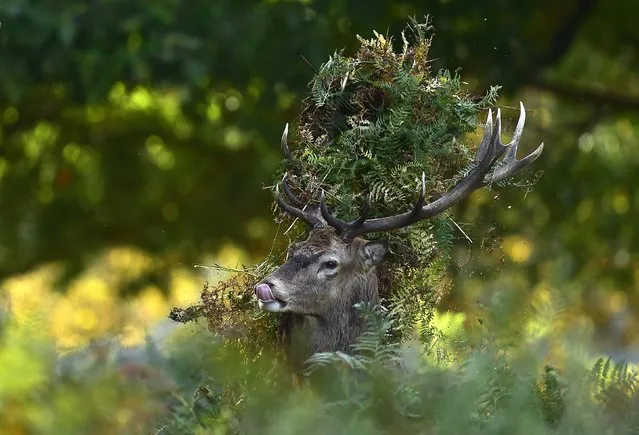
A male red deer with antlers covered in bracken, walks through undergrowth in Richmond Park in south west London, in this October 3, 2014 file photo. Although Richmond Park is only 3.69 square miles (9.56 square kilometres) wide and 650 deer graze there during the autumn deer rutting season, I spent nine hours on foot with my 500mm lens as well as shorter optics following the haunting and spine tingling barking of the male deer. Trying to find strong images of animal behaviour combined with attractive light and backgrounds. The mist had long gone and the sun was dipping lower to the horizon when I found the male in the photograph in the undergrowth. I had followed him for roughly an hour before this frame, and an hour afterwards, hoping he would either get an even more impressive head-dress, pick a battle with another male or chase some potential mating partners...but eventually the light went and so did I shortly after. I think the bracken stuck amongst the deer antlers gives the picture a certain appeal by adding a little humour to a natural history photograph, with a hat-like appearance, plus the tongue out looks a little as if the deer is licking his lips! (Photo and caption by Toby Melville/Reuters)
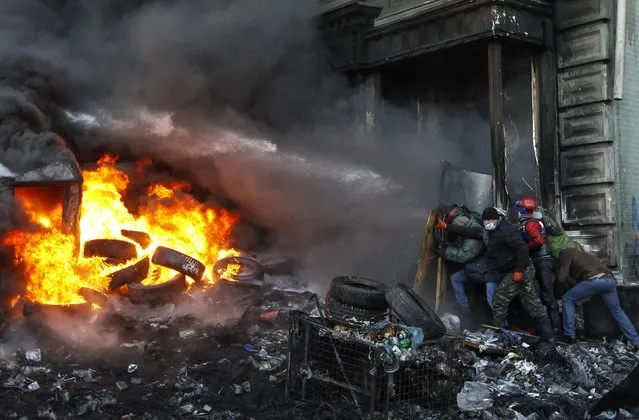
Pro-European integration protesters take cover from water sprayed from a fire engine at the site of clashes with riot police in Kiev in this January 23, 2014 file photo. Everyday protestors moved up to the barricades, made from burnt buses and cars, to clash with the police. It was winter, cold, and police used water hoses to turn the streets in front of the barricades to ice. The protestors kept moving up to the police positions to throw molotov cocktails and the police kept driving them back with rubber bullets and water hoses. This was happening for many days. Molotov cocktails were everywhere – in the air, being thrown at the police and behind barricades ready to be used. The flag of Ukraine was seen everywhere, and one song was sang many times a day – the Ukraine anthem. To shoot pictures every day in a bulletproof vest and helmet, while walking among the piles of burnt tires and avoiding rubber bullets was a challenge. I was surprised by the strong desire of the protestors to change something in their life, how they helped each other – many people, including the very old, brought warm clothes and hot food to them. (Photo and caption by Vasily Fedosenko/Reuters)
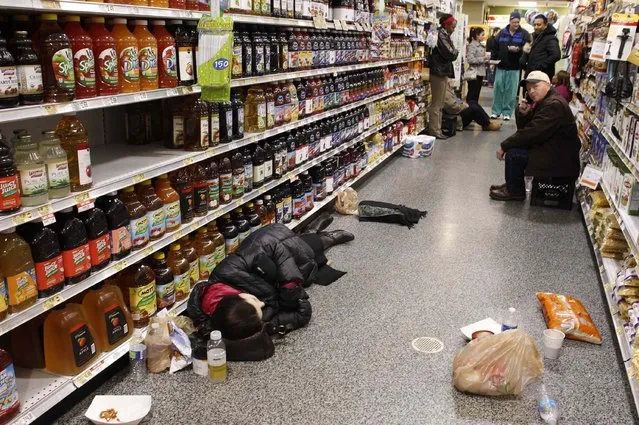
People hang out in a Publix grocery store after being stranded due to a snow storm in Atlanta, Georgia, in this January 29, 2014 file photo. Atlanta is usually known for its mild winters but when an ice storm began hitting the Metro area directly, traffic reached nightmarish proportions and vehicles became stranded for long hours. I began my day on another assignment 100 miles north of Atlanta but immediately headed back when I saw the snowfall. Having grown up there, I know the back roads well, which helped as I hit traffic in the northern suburbs. I began taking pictures and transmitting what I could on the drive, arriving into the city at sunrise. My sister said a friend of hers was stuck at a Publix grocery store that stayed opened all night to shelter and feed people. Ironically, I had slid into a bush nearby so after extracting my car, I went to the store to take pictures. The scene was surreal; scattered people slept soundly on the floor or tried to stay awake. Several of the pictures were widely published and friends called me from all over to ask about them. In total I spent over 30 hours in my car before I made it home. (Photo and caption by Tami Chappell/Reuters)
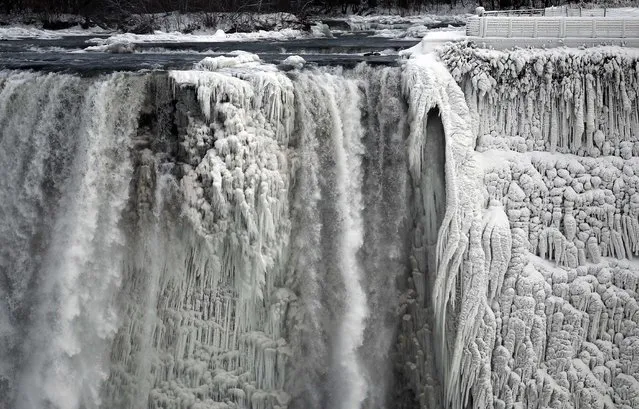
The U.S. side of the Niagara Falls is pictured in Ontario, in this January 8, 2014 file picture. I was out on a specific assignment to photograph the partially frozen Niagara Falls. There was a lot of angry muttering under my frozen breath that day, mostly asking myself why I lived there in winter, laced with several expletives. I wasn't outside for very long, but taking photographs in such a bitter-cold temperatures was challenging. I was dressed appropriately for the weather, but the bone-cracking cold still pierced through all the layers. I had only brought two cameras and two lenses knowing there was no way I'd be changing anything out there. For such a static landscape image I thought it was strong, and from what I've seen and heard, it was widely published. I didn't think the image would strike the chord it did, as I've never photographed a weather feature generating so much of a reaction. I think it was a testament to how strongly people felt about the miserable winter we had to endure. (Photo and caption by Aaron Harris/Reuters)

Riot police use pepper gas against residents of the Telerj slum as they attempt to repossess the land in Rio de Janeiro, in this April 11, 2014 file picture. I was shooting the clear-out by the police of a building which belonged to a giant telecommunications company and had been taken over by homeless people a week earlier. It was my third day there as I was doing a photo essay on the occupation and I was more interested in the aesthetics of the shacks and how people managed to build a home. Still, there was tension in the air that the police could invade the place at any moment. When I arrived that morning, it was still dark and I saw more than 1,000 police officers surrounding the area. Some of the homeless were leaving on their own but there was a lot of confusion and small riots outside. I took this picture about 15 minutes after I managed to enter the area, which was very challenging. The image is both strong and sad because the man is poor, black, unarmed and helpless against a whole squad of a heavily armed police spraying tear gas right into his eyes. (Photo and caption by Ana Carolina Fernandez/Reuters)
27 Nov 2014 15:01:00,
post received
0 comments
